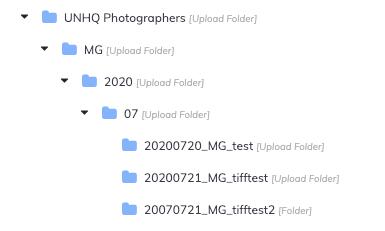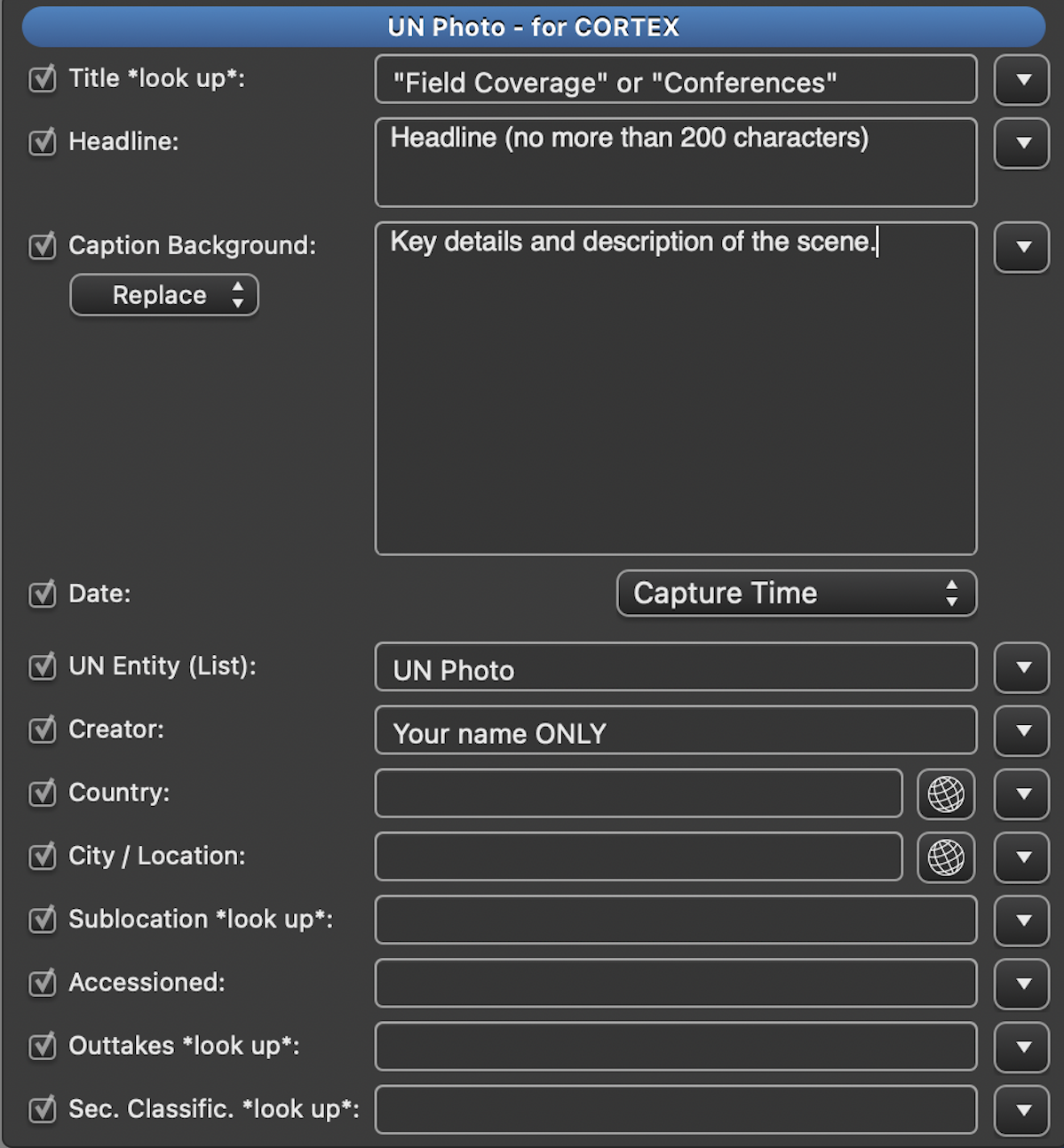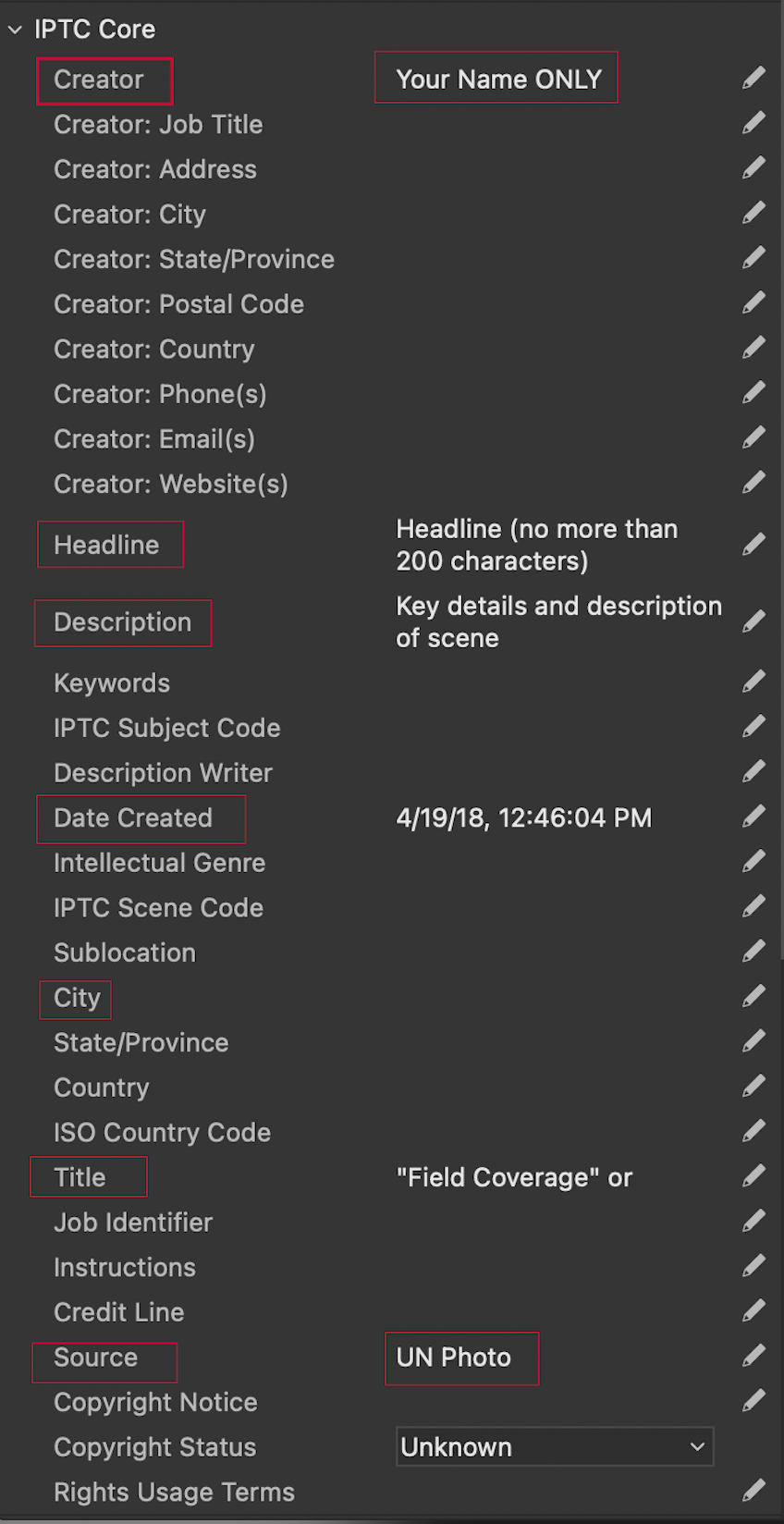Guidelines for Submission of Photos to UN Photo Digital Assets Management System for News and Media Production, Distribution as well as Archival Collection Development and Long-Term Preservation

Click here to view the pdf file in new browser window
1. INTRODUCTION
These guidelines are intended for photographers and multimedia content producers, UN agencies, field staff, and affiliated professionals and individuals working as UN staff or as contractors to submit photographs for news and media production, distribution and licensing to the UN global audience, as well as for long-term archival of purposes by the Department of Global Communications (DGC) at United Nations Headquarters in New York.
DGC welcomes the submission of photographs as well as related metadata and documents from contributors that must comply with the following guidelines and minimum requirements. Photographs can be easily and quickly uploaded to the UN Photo Digital Assets Management System based on Orange Logic Cortex.
Notice that DGC does not have the mandate nor the capacity to hold and manage the photographic production throughout the life cycle and the mandate of other offices and field mission. All Secretariat offices will have to sign a Service Level Agreement (SLA) for sharing the costs of OL-Cortex for the management of their photographic archives. The Department does not accept the transfer of photographs or other audio-visual materials whenever the missions are at the stage of liquidation. All contents must be produced by UN staff or in case of producers or photographers hired by assignment under a UN contract, all contents must be copyrighted and wholly owned by the United Nations. No third-party contents should be submitted unless there is a formal signed agreement transferring the full copyright to the United Nations.
UN Photo (dam.media.un.org) encourages photo submissions from UN offices away from Headquarters, agencies, programmes, and funds as well as field mission offices as part of their work and to fulfill DGC’s mission to foster public understanding of the work of the United Nations and its goals. Targeting at media organizations, governments and non-governmental organizations, researchers and civil society at large, UN Photo aims at presenting on its website a broad variety of the UN system’s activities captured in the medium of photography.
2. THEMATIC COVERAGE
The Photo coverage illustrates the various UN activities in the area (for example: documentation of mission life, peacekeeping personnel, patrols, outreach activities, high-level visits, day in the life stories, etc.) and/or subjects such as newsworthy events, cultural activities, civil society activities, or characteristics of the region where UN entities and affiliates engage (e.g. population, landmarks, street scenes, ethnic and cultural traditions of the local population, etc.) We are interested in seeing the work of the greater UN family in all of its various facets, including contributions made by civilian, military, police components, as well as to see documentation of the efforts made by Agencies, Funds, and Programmes, ideally with some level of partnership with, or support from Secretariat Departments.
3. MINIMUM TECHNICAL SPECIFICATIONS
- Minimum camera resolution: 18 megapixels or larger
- Photo size: minimum 11 inches (28 cm.) on the short side at 300 DPI resolution.
For example:
11 inches x 16.5 inches (~28 x 35 cm) or,
12 inches x 18 (~30 cms x 45.5 cms)
- File type: 8-bit, Tiff
- Color Space: Adobe RGB
- Images should be fully captioned. The caption is to be embedded (in English) in the IPTC metadata (See CAPTIONS).
- For scanned photos: longest dimension 12 inches, scanned at 300 DPI, file size submitted as Tiff.
4. METADATA REQUIREMENTS
Photographs are required to be fully captioned and must be verified through Cortex/Orange Logic upload manager. Prior to uploading, metadata may be entered through various editing programs such as Photo Mechanic, Photoshop, Lightroom or can simply be entered in during the uploading process.
Mandatory embedded metadata must include:
- Object Name / Title: “Field Coverage” or if coverage is in a headquarters “Conference”
- Headline
- Caption
- Source / UN Entity
- Photographer/Creator’s Full name only
- Country and City
- Capture date and time (It's important to be accurate)
Images without embedded information will not be reviewed or considered for use.
Caption Background Example:

Burial teams of volunteers in Guinea, wearing full personal protective equipment and working in teams of seven, disinfect themselves after carrying the body of a 40-year-old woman who died from Ebola. The Red Cross is undertaking safe and dignified burials in all Ebola-affected countries, ensuring that those who have died from the disease are treated with respect, while also ensuring the safety of communities.
5. TRANSMISSION AND ARCHIVING
Image files should be submitted via upload to Cortex through the system uploader following the naming convention rules set forth though this workflow document. No other form of submissions will be accepted to include email, WeTransfer, Dropbox, sFTP, etc.
The user/uploader must follow the UN Photo archiving standards by keeping the following 3 levels of folder structure with the respective naming convention. Within Cortex and upon the status of the user/uploader, an Upload folder with the initials (AA), will be accessible under the respective Office group.
The user/uploader will create a parent Upload Folder named with the coverage/assignment year (YYYY). Inside it, a child Upload Folder named with the coverage/assignment month (MM). Each individual coverage/assignment may be named starting with the date (yyyymmdd) followed by the photographer initials to end with a short and minimal description of the event.
Example:

6. USAGE
The United Nations retains all copyright entitlements to all photographs submitted to UN Photo and its archives. All Photos will be credited to the United Nations and the photographer as following: UN Photo/Name of photographer.
Any photo provided by a Photographer hired by a UN office for a specific assignment, written proof of rights of use, archive and distribution of such services must be provided to DGC signed and in PDF format.
See full UN Photo Usage Guidelines here.
7. MANDATORY IPTC FIELDS IN PHOTO EDITING SOFTWARE
7.1 IPTC fields in Photo Mechanic: template available upon request
UNHQ Photographers | Field and Contractual Photographers

7.2 IPTC fields in Adobe Bridge

7.3 IPTC fields in Adobe Lightroom

7.4 IPTC fields in Photoshop



7.5 IPTC fields in Cortex Photographer details panel
